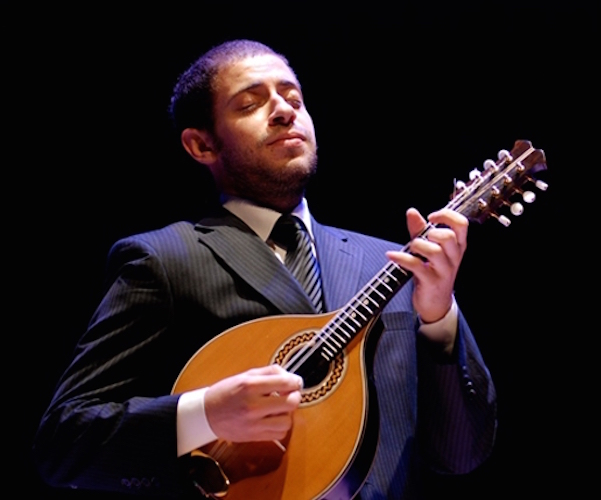Music Interview: Danilo Brito — Master of the Choro Mandolin
Brito was a child prodigy who originally began playing both the mandolin and the four-stringed cavaquinho, another staple of choro music.

Brazilian mandolin star Danilo Brito. Photo: Maria Camillo.
By Noah Schaffer
Ask mandolin giants like David Grisman and Mike Marshall what they’re listening to, and you won’t necessarily hear about some hot bluegrass picker. They’re as likely to cite the inventive Brazilian mandolinists who come out of the country’s choro scene.
One of those choro mandolin stars is 32-year-old Danilo Brito, who plays Cambridge’s Club Passim on Wednesday with his high-gear string quintet.
“Choro was the first genuine authentic Brazilian music,” says Brito, speaking through his manager/translator. “From choro came all the other Brazilian genres. So we play not only choro but also samba, from Rio, and forro, which is from the Northeast of Brazil.”
Although the literal definition of choro is “to cry” or “lament,” the music frequently consists of upbeat instrumentals mixed in with more plaintive compositions. “Some of our styles, like forro, were born from the influence of European polkas, and when Brazilians started to play them slower they became more melancholic,” says Brito. “The musicians found some very unique ways of expressing of their feelings. Our music is not always sad — it can be really cheerful. There are lots of variations of rhythm, melody, and feelings. But it’s always an intense feeling.”
Brito was a child prodigy who originally began playing both the mandolin and the four-stringed cavaquinho, another staple of choro music. “When I was three I played cavaquinho and mandolin, but at 12 I started to dedicate more of my time to the mandolin. I think my father, who also played both, suggested that the mandolin is a more proper instrument for becoming a soloist. I think I can express myself better with it, but I’m not really sure what attracted me to it,” he says.
Artists like Brito and his fellow mandolin hotshot Hamilton de Hollanda have put the spotlight on choro. While Brito’s group uses traditional instruments like the cavaquinho and a 7-string guitar, they’re not afraid to extend the tradition.
“We try to be original at any cost, but with Brazilian instrumental music as the basis,” he explains. “What matters is if you are expressing the music with your heart. I have a lot of respect for the tradition, but I try to play what I believe is honest.”
Such an approach has led to collaborations with bluegrass-bred artists like Grisman and Marshall.
“They’re really good at communicating through music,” observes Brito of his American mandolin peers. “Music doesn’t have frontiers. Both American and Brazilian traditional music have the same fathers: classical music and African rhythms. And they were actually both born around the same time.”
Playing choro for American audiences who may be new to the century-old sound has its cross-cultural benefits, reports Brito. “In Brazil we have this very well-known song, Carinhoso by the composer Pixinguinha. People of all ages know it, it’s very popular. So we may play it so often we forget how beautiful it is. When we play this song to an audience that is hearing a song from 1917 for the first time we can feel how touched they are. Because the song is so complex and well-structured but also very simple in how it communicates. It goes straight to the heart.”
Over the past 15 years Noah Schaffer has written about otherwise unheralded musicians from the worlds of gospel, jazz, blues, Latin, African, reggae, Middle Eastern music, klezmer, polka and far beyond. He has won over ten awards from the New England Newspaper and Press Association.
